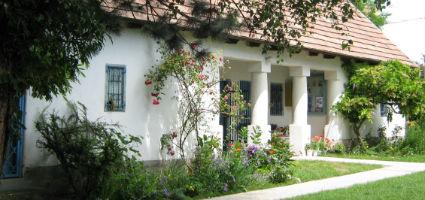2024. April 25. Thursday
Village Museum, Nagytarcsa - Nagytarcsa
 |
Address: 2142, Nagytarcsa Múzeumkert u. 21.
Phone number: (70) 379-8262
Opening hours: Tue-Wed 10-16, Thu-Fri 10-14
|
Museum tickets, service costs:
|
Ticket for adults
|
250 HUF
|
|
|
Ticket for students
(Hungarian)
|
100 HUF
|
|
|
Ticket for pensioners
(Hungarian)
|
100 HUF
|
Most of the instruments exhibited were made by the peasants themselves. The ornamentation and the forms prove the cleverness and artistic talent of the craftsmen.
First of all we can learn about the instruments of grape growing. We may see for instance a basket made for children, a grape press, as well as a cone and a small cask made by the last cartwright master of the village in 1917-ben.
The history of the fertiliser drawing fork is rather interesting. When the houses were covered by thatched roofs, it was an obligation to keep this fork by the side of the well, and use it in case of fire for the removal of the roof section in flames. When the reed was changed to clay toles, this tool was no longer used for the original purpose. The peasants used to draw down the manure from the cart.
We can also learn about the plowing, sowing and reaping instruments. After the sowing the agricultural labour paused for a little. It was time for repairing and supplementing the instruments.
When the grains ripened, the harvest followed. The instruments herein used were very simply, and the labour with them demanded very large efforts. The picked grain piles were tied into sheaves by the harvest man. The sheaves were put on the cart widened over the guest side. They were carried home and there placed in big ricks, to be preapered for the threshing process.
The items used for animal husbandry, baking, hoouse building, etc are also demonstrated.
First of all we can learn about the instruments of grape growing. We may see for instance a basket made for children, a grape press, as well as a cone and a small cask made by the last cartwright master of the village in 1917-ben.
The history of the fertiliser drawing fork is rather interesting. When the houses were covered by thatched roofs, it was an obligation to keep this fork by the side of the well, and use it in case of fire for the removal of the roof section in flames. When the reed was changed to clay toles, this tool was no longer used for the original purpose. The peasants used to draw down the manure from the cart.
We can also learn about the plowing, sowing and reaping instruments. After the sowing the agricultural labour paused for a little. It was time for repairing and supplementing the instruments.
When the grains ripened, the harvest followed. The instruments herein used were very simply, and the labour with them demanded very large efforts. The picked grain piles were tied into sheaves by the harvest man. The sheaves were put on the cart widened over the guest side. They were carried home and there placed in big ricks, to be preapered for the threshing process.
The items used for animal husbandry, baking, hoouse building, etc are also demonstrated.